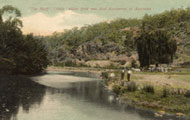- Agriculture
- Object :: Bush repaired Scoop
- Object :: Tumbling Tommy
- Interview :: Murray Smith
- Interview :: Peter Darley
- Windmills, pumps, steam power and engines
- Interview :: Max Jones
- Chaff Cutting
- Object :: Water Barrel
- Object :: Furphy Water Cart
- Ophir
- Object :: Gold Washing Cradle
- Object :: Picks and Mining Pan
- Object :: Chinese Scroll
- Object :: Chinese Shoulder Yoke
- Lucknow
- Historic Cadia
- Water at Cadia Valley Operations
- Interview :: John Ford
- Interview :: Joel Fossilo
- Object :: Testing Apparatus
Ophir
In 1851 Australia's first gold rush started at Ophir. Alluvial gold was washed in the creek using a cradle – an apparatus developed on the Californian goldfields to wash soil and separate gold. People flocked to Ophir to try their luck. Alluvial and reef mining took place. Central to the operation at Ophir was the creek, for not only did the creek bed contain gold, but also the water was used in mining as well as being a source of water for the miners.
The Ophir field attracted Chinese miners, who set up camp along the creek. Threaded across the hills of Ophir are kilometres of water races. These structures were constructed to collect water off the hills during wet weather, and to redirect water flow from the creek and tributaries to the mine sites. Often called Chinese water races, these amazing engineering feats were generally constructed by European mining groups, following the technology of ancient Chinese water races.
With the influx of miners to the area, there was opportunity for astute traders to establish shanties and hotels. Wells were sunk to provide domestic water to service these businesses.
Dotted around the Ophir landscape are the relics of the mining past – not only the mines and the water races, but also vestiges of cottages and buildings from the golden days of Ophir.
At Ophir, Summer Hill Creek echoes the past. Its waterfalls and winding stream are part of a spectacular scenic backdrop to a unique part of our history.

